Influence of Loading Rate on the Energy Evolution Characteristics of Rocks under Cyclic Loading and Unloading
Abstract
:1. Introduction
2. Test Materials and Methods
2.1. Rock Sample
2.2. Test Flow
3. Mechanical Deformation Characteristics of Rock Under Cyclic Loading and Unloading
3.1. Effect of Loading Rate on Mechanical Characteristics
3.2. Influence of Loading Rate on Deformation Characteristics
3.2.1. Deformation Characteristics before Peak Strength
3.2.2. Deformation Characteristics in the Softening Stage
3.3. Influence of Loading Rate on Macroscopic Failure Structure
4. Energy Evolution Characteristics of Rocks Under Cyclic Loading and Unloading
4.1. Calculation Method of the Energy Parameters
4.2. Energy Evolution Process
- When σ = 12.5–17.5 MPa, the plastic energy, elastic energy, and input energy increase slowly with an increase in the stress level, whereas the dissipation energy increases rapidly compared with the other stages. This shows that the internal and external forces are very small, the elastic energy just begins to accumulate, and the plastic energy is only released in a short period of time, whereas the primary pores easily close when acted on by external forces; thus, the relative movement between particles suddenly occurs, which causes the dissipation energy to increase rapidly.
- In the stage of 17.5–22.5 MPa, the growth rates of the plastic, elastic, and input energies are higher, whereas that of the dissipation energy remains constant. Furthermore, it is considered via analysis that the larger loading stress causes more particles to rebound after deformation, and this accelerates the increase of the overall elastic energy. Additionally, the friction and sliding behaviours of particles are more active under higher compression, and this results in a faster increase in the plastic energy. However, the rock is in the late compaction stage, and the pores are mostly compacted. This results in a slight consumption of dissipation energy.
- At the stress level in the range of 22.5–32.5 MPa, the energy increases steadily and linearly, and the difference between the input energy and elastic energy increases gradually. This is because the stress concentration of the fracture leads to its continuous regeneration and expansion, which leads to an increase in the proportion of plastic energy in the input energy.
- At the stress level in the range of 32.5–37.5 MPa, the elastic energy increases at the same speed as the input energy for the first time, and the plastic energy and dissipation energy increase at the same speed. This indicates that the rock is in the linear elastic stage at this stress level. Thus, it mainly produces recoverable elastic deformation. Therefore, a large amount of accumulated elastic energy leads to an increase in plastic energy, which is not enough to affect the growth consistency of elastic energy and input energy. Moreover, under a large stress, the rock initially exhibits damage. This in turn leads to an increase in the dissipation energy, which is basically consistent with the growth speed of plastic energy.
- At the stress level in the range of 37.5–42.5 MPa, the growth rate of each type of energy slows down uniformly. This indicates that at this stress level, the rock is in the plastic stage, and the pores begin to coalesce. The pores that begin to coalesce but have not completed reduce the effective contact area between the rock skeleton and particles, inhibit friction and sliding behaviour, and lead to a decrease in the growth rates of the plastic energy and dissipation energy. The decrease in the contact area also reduces the continuity between particles, and results in the slow speed of storage elastic energy.
- At the stress level in the range of 42.5–47.5 MPa, the energy increases suddenly and significantly. This indicates that at the late plastic stage, a large number of cracks on the rock are exhibited, and a large stress concentration is formed at the crack tip, which causes extensive expansion of macro cracks and continuous production of plastic strain. This leads to the consumption of large amounts of plastic energy and dissipation energy of the rock. Thus, a sudden increase in energy after the slow increase is the precursor of rock mass instability.
4.3. Characteristics of Energy Evolution under Different Loading Rates
4.4. Evolutionary Characteristics of the Elastic Energy Index under Different Loading Rates
4.5. Evolutionary Characteristics of Damping Ratio under Different Loading Rates
4.6. Effect of Loading Rate on Energy in the Softening Stage
5. Conclusions
- Under cyclic loading and unloading, the plastic strain in the entire test was directly proportional to the loading rate, and the residual stress and strength were inversely proportional to the loading rate. During loading and unloading, the plastic strain exhibited a decreasing–stabilising–increasing trend. The decreasing extent was less than the increasing extent. A smaller loading rate restrained the increase in plastic strain, and a higher loading rate caused the plastic strain in the increase zone to increase earlier.
- The difference in plastic strain under different loading rates is mainly concentrated in the residual resistance process, which produces plastic deformation and coalesces the cracks simultaneously. The released plastic and dissipation energies are inversely proportional to the loading rate.
- Under loading and unloading, the relationship between the energy value and increasing extent is as follows: input energy >; elastic energy >; plastic energy >; dissipation energy, and the first three types of energy exhibit a slow–fast–slow increase trend. However, dissipation energy exhibits a fast–steady–fast–slow–fast increase trend. Furthermore, the elastic energy index exhibits a large increase–steady increase–decrease trend. This is proportional to the loading rate, and there is no decrease section under a large loading rate. Additionally, the damping ratio exhibits a decrease–increase–decrease–increase–decrease trend. This is proportional to the loading rate in the compaction stage and inversely proportional to the plastic stage.
- The phenomena of a sudden increase after the slow increase in various energies and the long-term increase or the initiation of a decrease in the elastic energy index can be regarded as the precursors to rock failure.
Author Contributions
Funding
Conflicts of Interest
References
- Manoj, N.B.; Vladimir, P. Fatigue and dynamic energy behaviour of rock subjected to cyclical loading. Int. J. Rock Mech. Min. Sci. 2009, 46, 200–209. [Google Scholar]
- Wang, H.; Yang, T.H.; Liu, H.L.; Zhao, Y.C.; Deng, W.X.; Hou, X.G. Mechanical properties and energy evolution of dry and saturated sandstones under cyclic loading. Rock Soil Mech. 2017, 38, 1600–1608. [Google Scholar]
- Xiao, F.K.; Liu, G.; Shen, Z.L.; Zhang, F.R.; Wang, Y.F. Energy conversion and acoustic emission(AE) characteristics of coal samples under cyclic loading. Chin. J. Rock Mech. Eng. 2016, 35, 1954–1964. [Google Scholar]
- Zhao, Y.C.; Yang, T.H.; Xiao, F.K.; Wang, H.; Liu, G.; Zheng, X.; Zhou, J.R.; Shen, Z.L. The variation law of plastic strain energy of western weak cemented sandstone during cyclic loading experiment. J. Chin. Coal Soc. 2015, 40, 1813–1819. [Google Scholar]
- Zhang, Z.Z.; Gao, F. Energy Evolution Mechanism during Rock Deformation and Failure, 2nd ed.; China University of Mining and Technology: Xuzhou, China, 2014. [Google Scholar]
- Zhang, Z.Z.; Gao, F. Experimental Investigations on Energy Evolution Characteristics of Coal, Sandstone and Granite during Loading Process; China University of Mining and Technology: Xuzhou, China, 2015; Volume 44, pp. 416–422. [Google Scholar]
- Dong, J.J.; Chen, S.S.; Xu, J.; Liu, Q.S. Mechanical properties and energy characteristics of mudstone under different containing moisture states. J. Chin. Coal Soc. 2018, 43, 2217–2224. [Google Scholar]
- Yang, J. Evolution Characters of Stress and Energy and Laws of Fractures and Damage in Coal Sample under True Tri-axial Loading-Unloading Test. Master’s Thesis, China University of Mining and Technology, Xuzhou, China, 2017. [Google Scholar]
- Wang, W.C. Study on Mechanism of Fatigue Damage Evolution of Deep Salt Rock of Yewu. Master’s Thesis, Henan Polytechnic University, Jiaozuo, China, 2016. [Google Scholar]
- Zhang, G.K.; Li, H.B.; Xia, X.; Li, J.R.; Yu, C.; Liu, J.S. Research on energy and damage evolution of rock under uniaxial compression. Rock Soil Mech. 2015, 36, 94–100. [Google Scholar]
- Jiang, C.B.; Duan, M.K.; Yin, G.Z.; Wang, J.G. Experimental study on seepage properties, AE characteristics and energy dissipation of coal under tiered cyclic loading. Eng. Geol. 2017, 221, 114–123. [Google Scholar] [CrossRef]
- Duan, M.K.; Jiang, C.B.; Yu, H.; Lu, T.Y.; Niu, B.W.; Sun, D.L. Experimental research on energy dissipation and seepage properties of coal under loading-unloading conditions at different stress levels. Rock Soil Mech. 2018, 39, 1346–1354. [Google Scholar]
- Meng, Q.B.; Han, L.J.; Pu, H.; Wen, S.Y.; Li, H. Experimental on the effect of strain rate and size on the energy accumulation and dissipation of rock. J. Chin. Coal Soc. 2015, 40, 2386–2398. [Google Scholar]
- Wang, J.X. Mechanical Properties and Energy Evolution of Marble under Triaxial Unloading. Master’s Thesis, Kunming University of Science and Technology, Kunming, China, 2016. [Google Scholar]
- Cieslik, J. Damage and Plasticity Rate Dependence of Luna Limestone in Uniaxial Compression. Rock Mechanics for Resources, Energy and Environment. pp. 233–237. Available online: www.onepetro.org/conference-paper/ISRM-EUROCK-2013-032 (accessed on 16 January 2019).
- Kim, E.; Garcia, A.; Changani, H. Fragmentation and energy absorption characteristics of Red, Berea and Buff sandstones based on different loading rates and water contents. Geomech. Eng. 2018, 14, 151–159. [Google Scholar]
- Millon, O.; Ruiz-Ripoll, M.L.; Hoerth, T. Analysis of the Behavior of Sedimentary Rocks under Impact Loading. Rock Mech. Rock Eng. 2016, 49, 4257–4272. [Google Scholar] [CrossRef]
- Li, Y.Y.; Zhang, S.C.; Wen, S.J.; Zhao, R.L.; Cao, Z.G.; Lun, Q.Z.; Bai, J.Z. Energy conversion and fragment distribution characteristics of coal sample under uniaxial cyclic loading. J. Chin. Coal Soc. 2019, 44, 1411–1420. [Google Scholar]
- Wang, X.R.; Wang, E.Y.; Liu, X.F.; Wang, H.; Li, X.L.; Li, D.H. Experimental study on the static loading rate effects of sandstone specimen containing pre-existing echelon cracks. J. Chin. Coal Soc. 2017, 42, 2582–2591. [Google Scholar]
- Chen, Z.Q. Study on Failure Process and Energy Mechanism of Hard-brittle Rock under Hydro-mechanical Coupling Action. Master’s Thesis, Chengdu University of Technology, Chengdu, China, 2015. [Google Scholar]
- Xiao, X.C.; Ding, X.; Zhao, X.; Pan, Y.S.; Wang, A.W.; Wang, L. Experimental study on acoustic emission and charge signals during coal failure process at different loading rates. Rock Soil Mech. 2017, 38, 3419–3426. [Google Scholar]
- International Society for Rock Mechanics. Basic geotechnical description of rock masses. Int. J. Rock Mech. Min. Sci. Geomech. Abstr. 1981, 18, 85–110. [Google Scholar]
- Yang, D.H.; Zhao, Y.X.; Teng, T.; He, X.; Wang, W.; Han, P.H. Experimental study on the influence of cyclic loading on Kaiser effect. Chin. J. Rock Mech. Eng. 2018, 37, 2697–2708. [Google Scholar]
- Li, S.L.; Zhou, M.J.; Chen, D.X.; Zhang, J.L.; Hu, J.Y. Experimental study on acoustic emission characteristics before the peak strength of rocks under incrementally cyclic loading-unloading methods. Chin. J. Rock Mech. Eng. 2019, 38, 724–735. [Google Scholar]
- Lu, Y.L.; Wang, L.G.; Yang, F.; Li, Y.J.; Chen, H.M. Post-peak strain softening mechanical properties pf weak rock. Chin. J. Rock Mech. Eng. 2010, 29, 640–648. [Google Scholar]
- Dahhaoui, H.; Belayachi, N.; Zadjaoui, A. Modeling of creep behavior of an argillaceous rock by numerical homogenization method. Period. Polytech. Civ. Eng. 2018, 62, 462–469. [Google Scholar] [CrossRef] [Green Version]
- Su, Z.D.; Sun, J.Z.; Xia, J.; Wu, C.L. Research on Effects of Freeze-Thaw Cycles on Acoustic Emission Characteristics of Granite. Chin. J. Rock Mech. Eng. Available online: Kns.cnki.net/kcms/detail/42.1397.o3.20190114.1724.001.html (accessed on 16 January 2019).
- Nikolic, M.; Ibrahimbegovi, A. Rock mechanics model capable of representing initial heterogeneities and full set of 3D failure mechanisms. Comput. Methods Appl. Mech. Eng. 2015, 290, 209–227. [Google Scholar] [CrossRef]
- Xiao, F.K.; Wang, H.R.; Liu, G. Study on Multiparameter Precursory Information Identification of the Fracture of Yellow Sandstone. Adv. Civ. Eng. 2019, 2019, 7676801. [Google Scholar] [CrossRef]
- Yang, H.; Sinha, S.K.; Feng, Y.; McCallenb, D.B.; Jeremić, B. Energy dissipation analysis of elastic–plastic materials. Comput. Methods Appl. Mech. Eng. 2018, 331, 309–326. [Google Scholar] [CrossRef] [Green Version]
- Nikolić, M.; Do, X.N.; Ibrahimbegovic, A.; Nikolić, Ž. Crack propagation in dynamics by embedded strong discontinuity approach: Enhanced solid versus discrete lattice model. Comput. Methods Appl. Mech. Eng. 2018, 340, 480–499. [Google Scholar] [CrossRef] [Green Version]
- Kivi, I.R.; Ameri, M.; Molladavoodi, H. Shale brittleness evaluation based on energy balance analysis of stress-strain curves. J. Pet. Sci. Eng. 2018, 167, 1–19. [Google Scholar] [CrossRef]
- Gong, F.Q.; Yan, J.Y.; Luo, S.; Li, X.B. Investigation on the Linear Energy Storage and Dissipation Laws of Rock Materials under Uniaxial Compression. Rock Mech. Rock Eng. 2019, 52, 4237–4255. [Google Scholar] [CrossRef]
- Song, D.Z.; Wang, E.Y.; Liu, J. Relationship between EMR and dissipated energy of coal rock mass during cyclic loading process. Saf. Sci. 2012, 50, 751–760. [Google Scholar] [CrossRef]
- Xie, H.P.; Li, L.Y.; Peng, R.D.; Ju, Y. Energy analysis and criteria for structural failure of rocks. J. Rock Mech. Geotech. Eng. 2009, 1, 11–20. [Google Scholar] [CrossRef] [Green Version]
- Inspection and Quarantine of the People’s Republic of China; China National Standardization Management Committee. GB/T 23561 Determination of Physical and Mechanical Properties of Coal and Rock; Standards Press of China: Beijing, China, 2009.


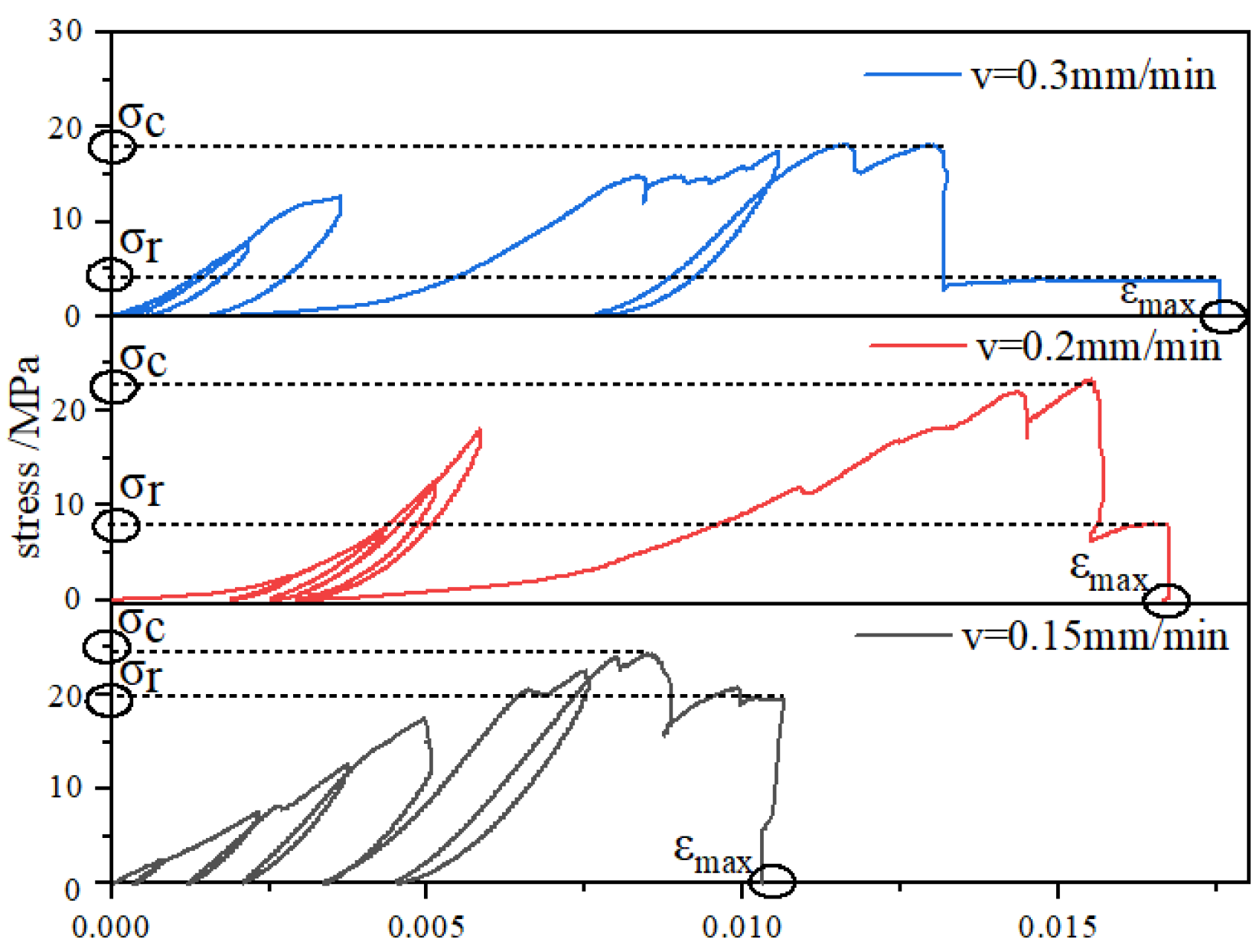
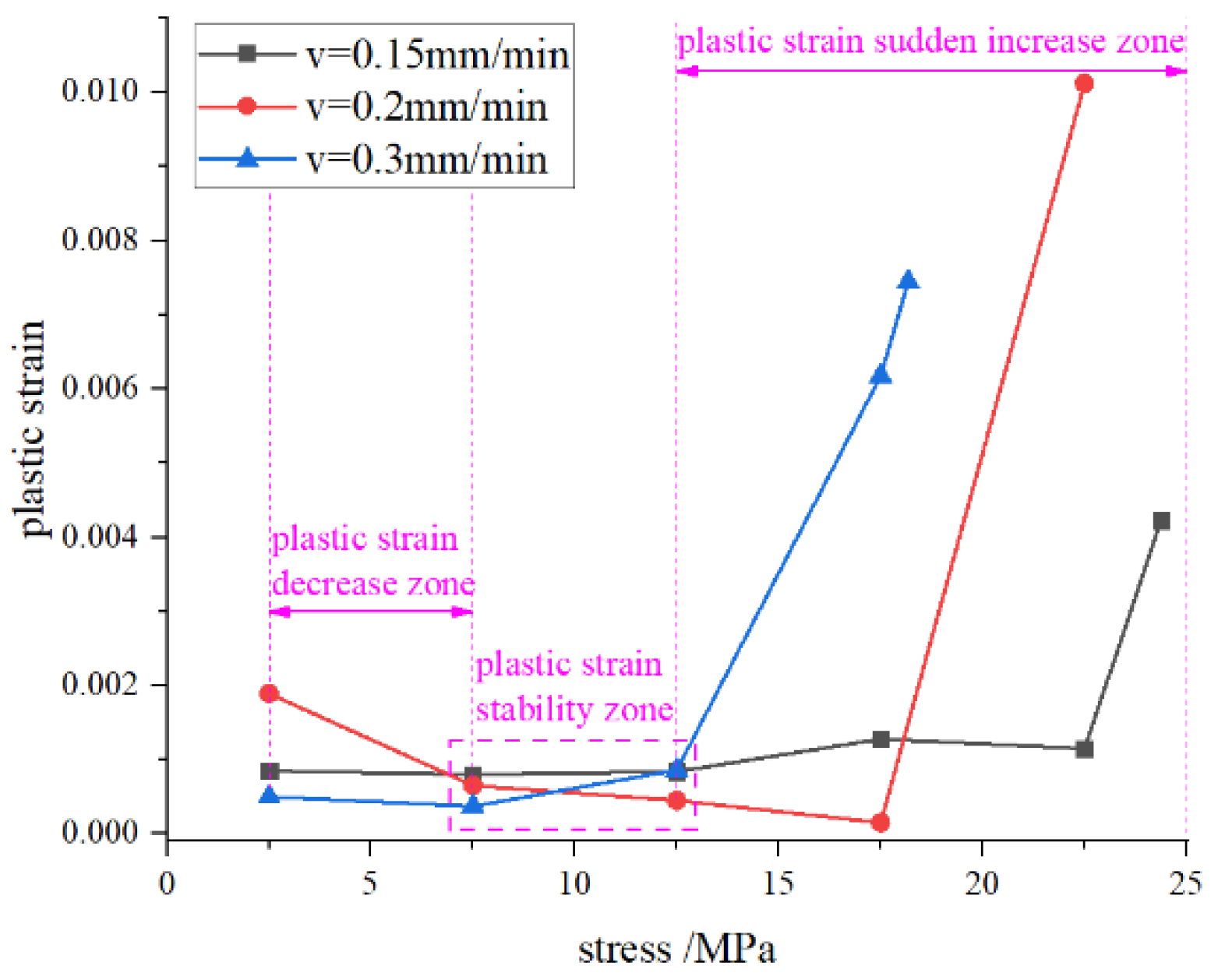


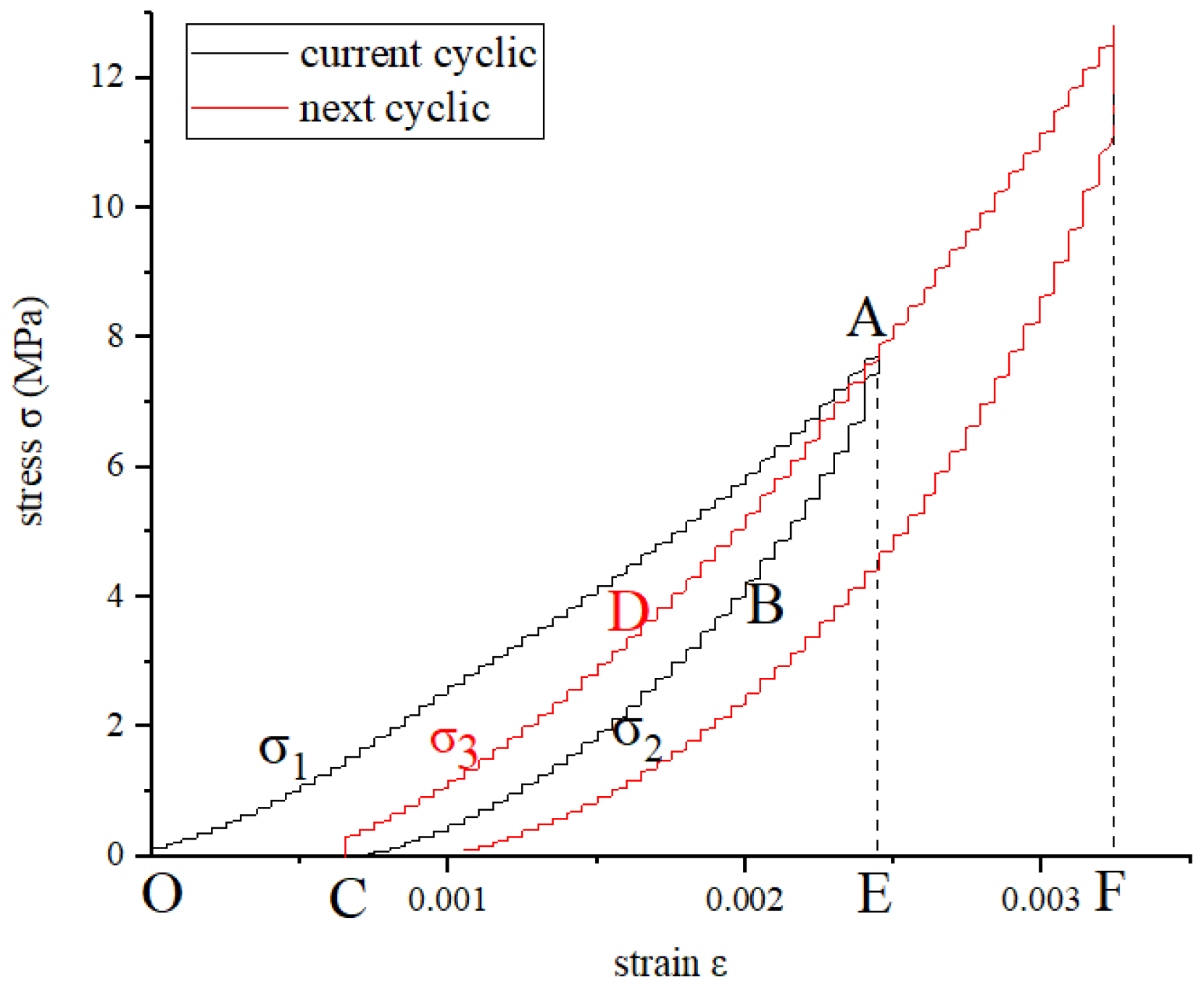
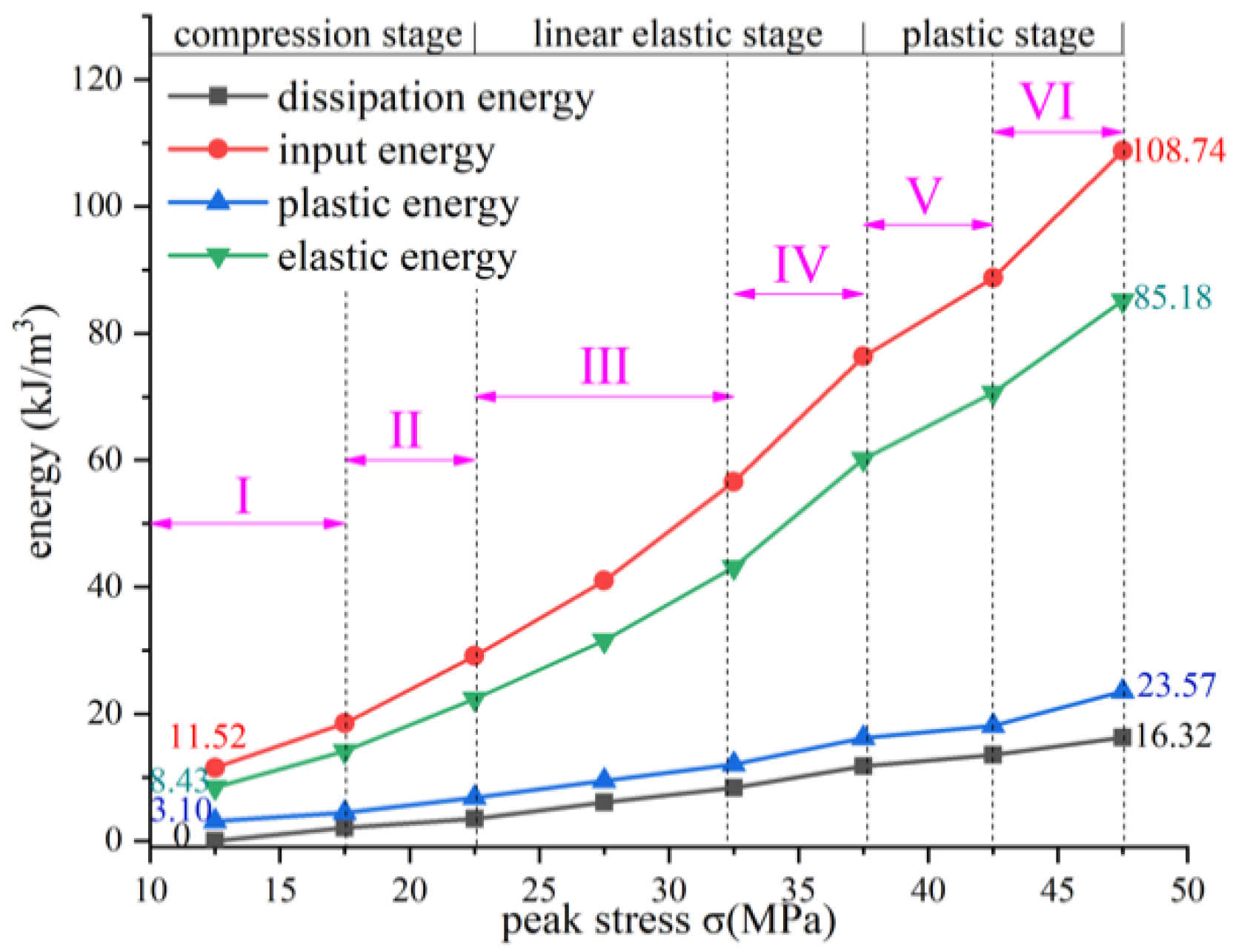



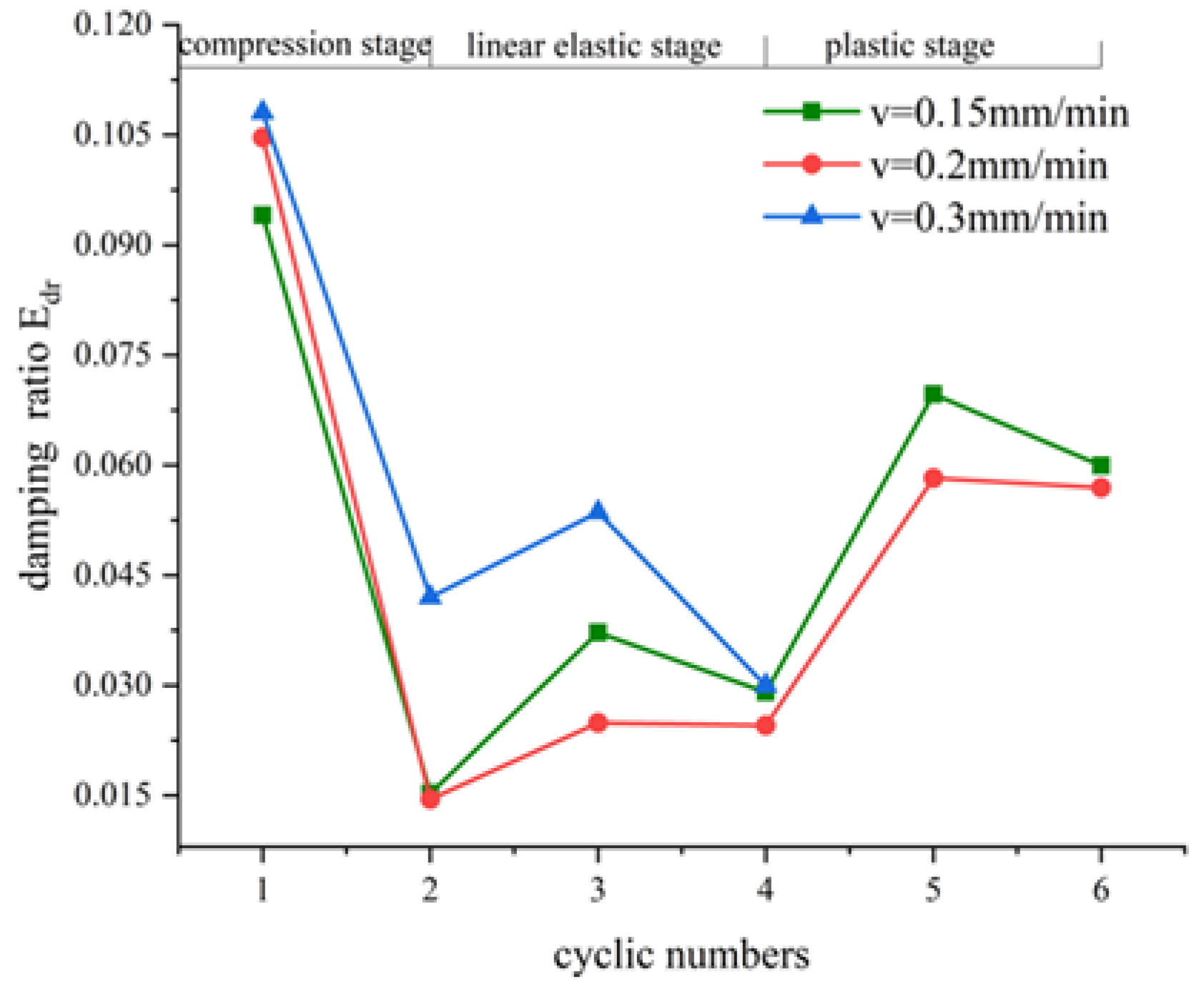
| Element | Ca | S | Zn | Fe | Si | Mg |
|---|---|---|---|---|---|---|
| Content, % | 60.194 | 2.704 | 0.274 | 0.818 | 0.222 | 0.212 |
| Mineral | Calcite, Dolomitecompounds | Serpentine | Pyrite | Talc | Zinc Sulphide | Quartz |
|---|---|---|---|---|---|---|
| Content, % | 94.4 | 1.4 | 2.2 | 1.0 | 0.8 | 0.2 |
| Plastic Strain | In the Softening Stage | In the Entire Test | |
|---|---|---|---|
| Loading Rate v (mm/min) | |||
| 0.15 | 0.00155 | 0.0103 | |
| 0.2 | 0.00338 | 0.01674 | |
| 0.3 | 0.00343 | 0.0168 | |
| Energy of the Softening Stage | Plastic Energy (kJ/m3) | Dissipation Energy (kJ/m3) | |
|---|---|---|---|
| Loading Rate v (mm/min) | |||
| 0.15 | 32.76428 | 4.332732 | |
| 0.2 | 12.44926 | 0.851863 | |
| 0.3 | 10.23707 | 0 | |
© 2020 by the authors. Licensee MDPI, Basel, Switzerland. This article is an open access article distributed under the terms and conditions of the Creative Commons Attribution (CC BY) license (http://creativecommons.org/licenses/by/4.0/).
Share and Cite
Li, J.; Hong, L.; Zhou, K.; Xia, C.; Zhu, L. Influence of Loading Rate on the Energy Evolution Characteristics of Rocks under Cyclic Loading and Unloading. Energies 2020, 13, 4003. https://doi.org/10.3390/en13154003
Li J, Hong L, Zhou K, Xia C, Zhu L. Influence of Loading Rate on the Energy Evolution Characteristics of Rocks under Cyclic Loading and Unloading. Energies. 2020; 13(15):4003. https://doi.org/10.3390/en13154003
Chicago/Turabian StyleLi, Jielin, Liu Hong, Keping Zhou, Caichu Xia, and Longyin Zhu. 2020. "Influence of Loading Rate on the Energy Evolution Characteristics of Rocks under Cyclic Loading and Unloading" Energies 13, no. 15: 4003. https://doi.org/10.3390/en13154003





